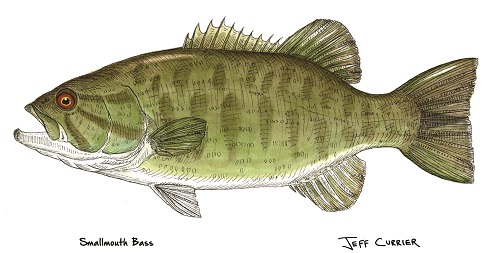 (Micropterus dolomieu)
(Micropterus dolomieu)
Description
The smallmouth bass is a member of the sunfish family (Centrarchidae). They are a top North American game fish. Usually they are brownish olive in color with dark brown vertical bands. The eye is usually red. Smallmouth bass are often mistaken for largemouth bass. With smallmouth when the mouth is closed the jaw extends as far as the middle of the eye. In largemouth the jaw extends past. With smallmouth the spiny section of the dorsal fin is connected to the soft rayed part of the dorsal fin. In a largemouth they they are not connected.
Size
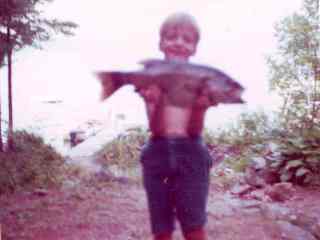 Smallmouth commonly reach 16 inches and 2 pounds with 20 inch fish weighing 4 to 5 pounds occasionally taken. At age five I watched my dad land a 23-inch, 6-pound trophy. He was so excited that he jumped up and down in the family rowboat only to cause a major leak that nearly ended in us sinking. I am certain that if the choice came he’d of saved his catch and let me fend for myself!
Smallmouth commonly reach 16 inches and 2 pounds with 20 inch fish weighing 4 to 5 pounds occasionally taken. At age five I watched my dad land a 23-inch, 6-pound trophy. He was so excited that he jumped up and down in the family rowboat only to cause a major leak that nearly ended in us sinking. I am certain that if the choice came he’d of saved his catch and let me fend for myself!
My Largest So Far

I’ve since caught a lifetime of smallies and many big ones as well, however, not a 23”! Here’s one of my largest. This lunker ate a Clouser Minnow in Chequamegon Bay on Lake Superior on September 16, 2022.
Distribution
The smallmouth bass is native in the Mississippi River Basin, St. Lawrence River, Great Lakes system and the Hudson Bay basin of North America. They have been introduced throughout much of the western United States including the famous John Day River of Oregon.
Habits
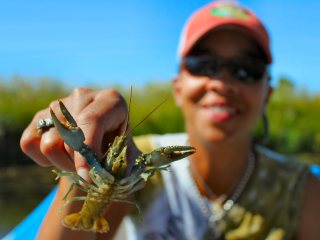 The feeding habits for smallmouth consist of searching close to their lairs, usually in 5 to 20 feet of water, for crayfish, minnows, hellgrammites, dragonfly larvae and other nymphs, depending upon where you live. They also devour surface foods including various insects as well as frogs and mice. Consistent weather patterns, good or bad, do not change these habits much, but cold fronts, heat waves, intense thunderstorms and unstable conditions send smallies to deep water and into a state of lockjaw.
The feeding habits for smallmouth consist of searching close to their lairs, usually in 5 to 20 feet of water, for crayfish, minnows, hellgrammites, dragonfly larvae and other nymphs, depending upon where you live. They also devour surface foods including various insects as well as frogs and mice. Consistent weather patterns, good or bad, do not change these habits much, but cold fronts, heat waves, intense thunderstorms and unstable conditions send smallies to deep water and into a state of lockjaw.
Personal Experience
 I grew up fly fishing for smallmouth bass. Every summer until I was twenty years old was spent at the family cottage on Lake Winnipesaukee in Wolfeboro, New Hampshire. Five days a week, ten weeks a summer I could be found popping the shallows either from boatyard piers or our 16-foot canoe on a glassy-smooth lake surface before sunrise and again after sunset. Practicing catch-and-release at an early age, I had pet smallies, knew what fly they would eat, and most importantly, where to find them under all weather conditions throughout the year.
I grew up fly fishing for smallmouth bass. Every summer until I was twenty years old was spent at the family cottage on Lake Winnipesaukee in Wolfeboro, New Hampshire. Five days a week, ten weeks a summer I could be found popping the shallows either from boatyard piers or our 16-foot canoe on a glassy-smooth lake surface before sunrise and again after sunset. Practicing catch-and-release at an early age, I had pet smallies, knew what fly they would eat, and most importantly, where to find them under all weather conditions throughout the year.
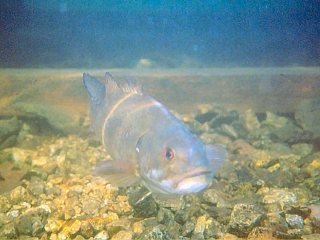 My smallmouth fly fishing season began about one month after ice-out, typical of all smallie regions. This is when water temperatures in the shallows reach the low sixties and smallmouth move there from winter depths to build nests and spawn. Incredibly protective of their eggs or fry, they will hit anything that threatens their nest from lures and flies to the toes of unwelcome swimmers. As a youngster, these easy-to-catch smallies were too much to resist. Every fly-concoction in my box worked, and as I kept catching fish, I developed my fly fishing skills.
My smallmouth fly fishing season began about one month after ice-out, typical of all smallie regions. This is when water temperatures in the shallows reach the low sixties and smallmouth move there from winter depths to build nests and spawn. Incredibly protective of their eggs or fry, they will hit anything that threatens their nest from lures and flies to the toes of unwelcome swimmers. As a youngster, these easy-to-catch smallies were too much to resist. Every fly-concoction in my box worked, and as I kept catching fish, I developed my fly fishing skills.
Eventually I outgrew this act, learning that every time I removed a smallmouth from its nest, pumkinseed sunfish and yellow perch from under our dock pilings were gobbling up the precious eggs and fry. Today, I preach against antagonizing spawning bass and encourage anglers to simply wait two weeks until they are done protecting their nest and return to their normal feeding habits.
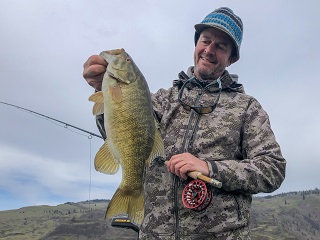 Some 50 years later my passion for smallmouth bass continues. I’ve caught smallies in many US states and Canadian provinces and even in South Africa. I recently moved to Hayward, Wisconsin where I’m now surrounded by some of the best smallmouth bass fishing of all!
Some 50 years later my passion for smallmouth bass continues. I’ve caught smallies in many US states and Canadian provinces and even in South Africa. I recently moved to Hayward, Wisconsin where I’m now surrounded by some of the best smallmouth bass fishing of all!
Fly Fishing Tactics for Smallmouth Bass
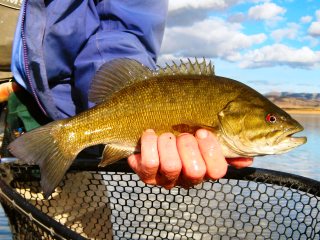 An important strategy for smallmouth fly fishing is to be prepared to fish top to bottom. Smallies are perhaps the most aggressive top-water feeders, and if exciting strikes are what you live for, begin with a noisy popper. Work the shallows in 4 to 8 feet of water, and with a good pair of Polarized sunglasses, look for submerged boulders, logs and other debris. Explore around rocky points, moored boats and close to docks. A good sidearm cast that sneaks a couple feet under an overhanging tree or into a covered boathouse on a developed lake will surely draw a strike. Just don’t let the owner see you do it.
An important strategy for smallmouth fly fishing is to be prepared to fish top to bottom. Smallies are perhaps the most aggressive top-water feeders, and if exciting strikes are what you live for, begin with a noisy popper. Work the shallows in 4 to 8 feet of water, and with a good pair of Polarized sunglasses, look for submerged boulders, logs and other debris. Explore around rocky points, moored boats and close to docks. A good sidearm cast that sneaks a couple feet under an overhanging tree or into a covered boathouse on a developed lake will surely draw a strike. Just don’t let the owner see you do it.
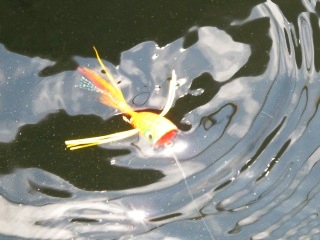 Smallies will often strike a fly the second it hits the water, but they also like to observe for many casts. Vary the idle time between pops, letting the popper sit dead for ten seconds, and if that’s not enough, try fifteen. If an area looks particularly good, work it with heart, making up to ten casts to the same spot with altered gurgling pops on each cast. If you catch one, don’t leave, smallmouth rarely hunt alone and often times more attempts to the same spot will produce another fish of comparable size.
Smallies will often strike a fly the second it hits the water, but they also like to observe for many casts. Vary the idle time between pops, letting the popper sit dead for ten seconds, and if that’s not enough, try fifteen. If an area looks particularly good, work it with heart, making up to ten casts to the same spot with altered gurgling pops on each cast. If you catch one, don’t leave, smallmouth rarely hunt alone and often times more attempts to the same spot will produce another fish of comparable size.
 Early mornings, evenings, and overcast days provide ideal top-water action, but success can be found outside of this prime window of opportunity. Amidst the middle of a bright sunny day, look for smallmouth in deeper water. Shade producing drop-offs, shelves, humps, huge boulders, and hollow logs close within an area that produces smallies early in the day will provide action now. Try channels or other deep water near the shallows, and break out the sinking line and dredge with a conehead streamer or a weighted crayfish pattern. Don’t hesitate to try large nymph patterns that imitate hellgrammites, damsels and dragonflies, or even stoneflies. Make repeated casts with varied stripping techniques like with poppers, before moving to a new location.
Early mornings, evenings, and overcast days provide ideal top-water action, but success can be found outside of this prime window of opportunity. Amidst the middle of a bright sunny day, look for smallmouth in deeper water. Shade producing drop-offs, shelves, humps, huge boulders, and hollow logs close within an area that produces smallies early in the day will provide action now. Try channels or other deep water near the shallows, and break out the sinking line and dredge with a conehead streamer or a weighted crayfish pattern. Don’t hesitate to try large nymph patterns that imitate hellgrammites, damsels and dragonflies, or even stoneflies. Make repeated casts with varied stripping techniques like with poppers, before moving to a new location.
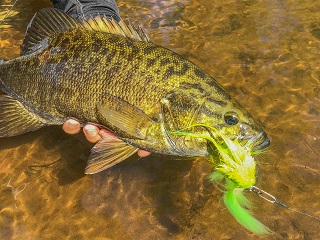 In the southern reaches of the smallmouth’s range, hot August temperatures can push them to nearly 30 feet of water just like a cold front will in their northern range. This is a great time of year to hunt smallies in rivers. High oxygen contents and often colder water temperatures keep smallies hungry and active during severe heat waves. Like trout, river smallies take advantage of aquatic hatches and targeting these occurrences can be a great deal of fun. Blind fishing with Poppers, frog imitations, and other surface flies as well as dredging with a simple Woolly Bugger can produce amazing action.
In the southern reaches of the smallmouth’s range, hot August temperatures can push them to nearly 30 feet of water just like a cold front will in their northern range. This is a great time of year to hunt smallies in rivers. High oxygen contents and often colder water temperatures keep smallies hungry and active during severe heat waves. Like trout, river smallies take advantage of aquatic hatches and targeting these occurrences can be a great deal of fun. Blind fishing with Poppers, frog imitations, and other surface flies as well as dredging with a simple Woolly Bugger can produce amazing action.
Equipment
Rod: 9-foot for a 6-weight line.
Reel: It’s unlikely that a smallmouth would pull heaps of line of the reel and thus require the need for backing. However, these guys pull hard and often hit the air a few times before dashing straight to the boulders of a hollow log. A reel with a strong smooth drag will help against a short but feisty run.
Line: 6-weight, weight forward floating, WF6F.
Leader: 6 to 71/2-foot for 10 to 16-pound tippet.
Flies: The best hook sizes are from 4 to 8. I’ve had luck on any imaginable color when the bite is on. One rule of thumb however is bright flies under the sun and darker flies in lower light. My favorite fly is the standard hard body popper. I also use grass hoppers and Chernobyl ants. Best subsurface flies are Clouser Minnows and crayfish patterns.
Learn More!
 Learn more about fly fishing for warmwater game fish by ordering an autographed copy of Jeff’s book, “Currier’s Quick and Easy Guide to Warmwater Fly Fishing”. Jeff’s popular book includes not just more strategies for smallmouth but also tactics and flies for largemouth bass, carp, perch, walleye, pike and more!
Learn more about fly fishing for warmwater game fish by ordering an autographed copy of Jeff’s book, “Currier’s Quick and Easy Guide to Warmwater Fly Fishing”. Jeff’s popular book includes not just more strategies for smallmouth but also tactics and flies for largemouth bass, carp, perch, walleye, pike and more!
Jeff’s Smallmouth Bass Art
Get Jeff’s Smallmouth Bass artwork on a variety of products by visiting his new and growing web store. Order one of his famous 15 oz coffee mugs, a frosted beer stein, a sunshirt or hoodie or a custom sharpie art Cliff Fly Box. You can even commission Jeff to paint the one you caught!
-
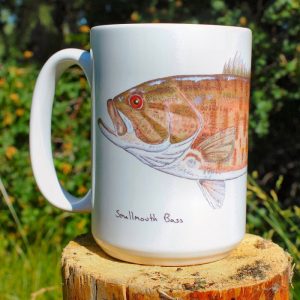
Smallmouth Bass | Coffee Mug | Jeff Currier
$29.95 Add to cart -

Smallmouth Bass | Solar Long Sleeve Shirt
$49.95 Select options This product has multiple variants. The options may be chosen on the product page -

Smallmouth Bass | Solar Hoodie
$69.95 Select options This product has multiple variants. The options may be chosen on the product page -
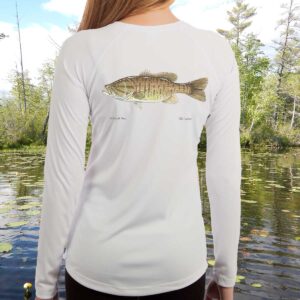
Smallmouth Bass | Ladies Solar Long Sleeve Shirt
$49.95 Select options This product has multiple variants. The options may be chosen on the product page -

Smallmouth Bass | Frosted Mug | Jeff Currier
$38.95 Add to cart

